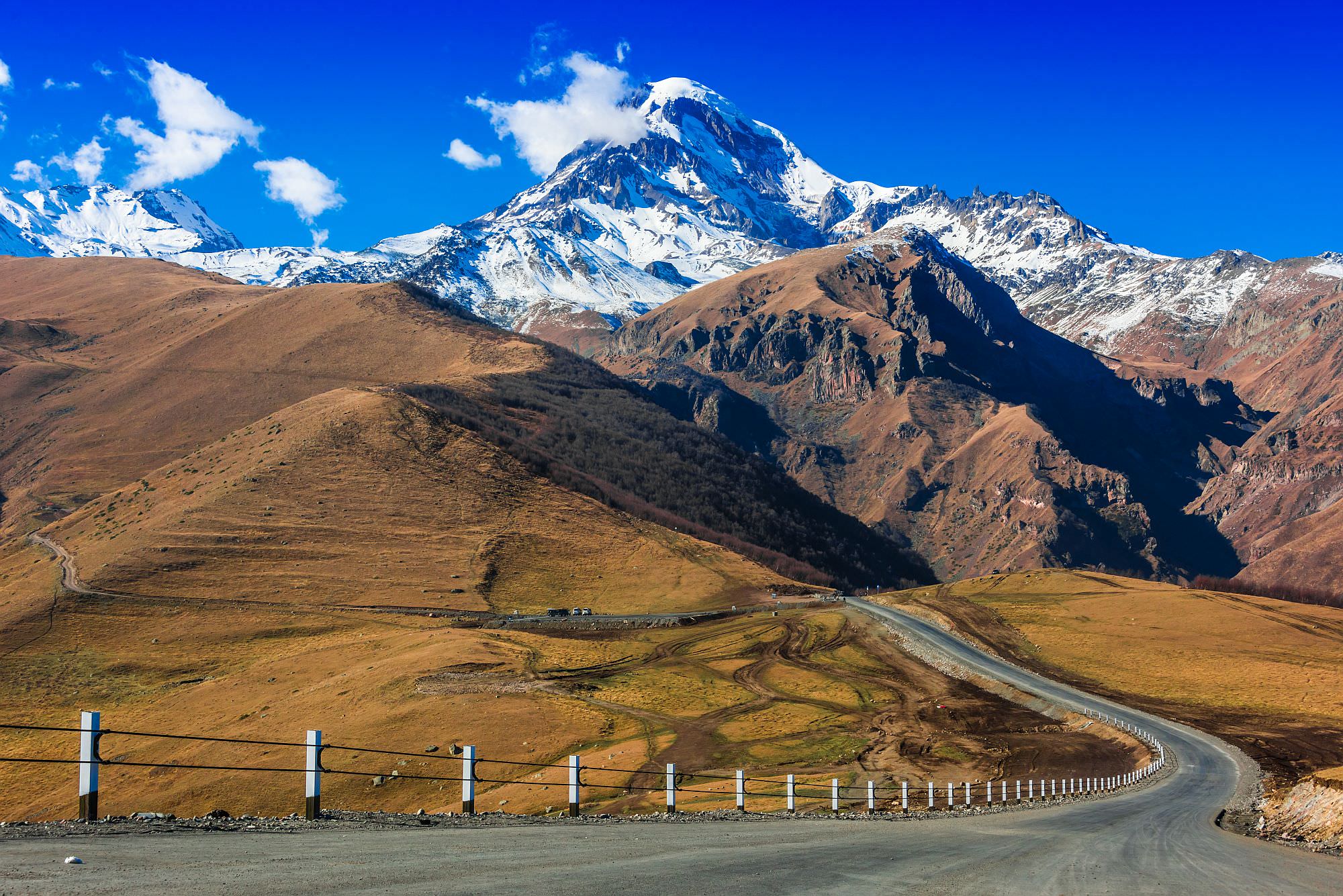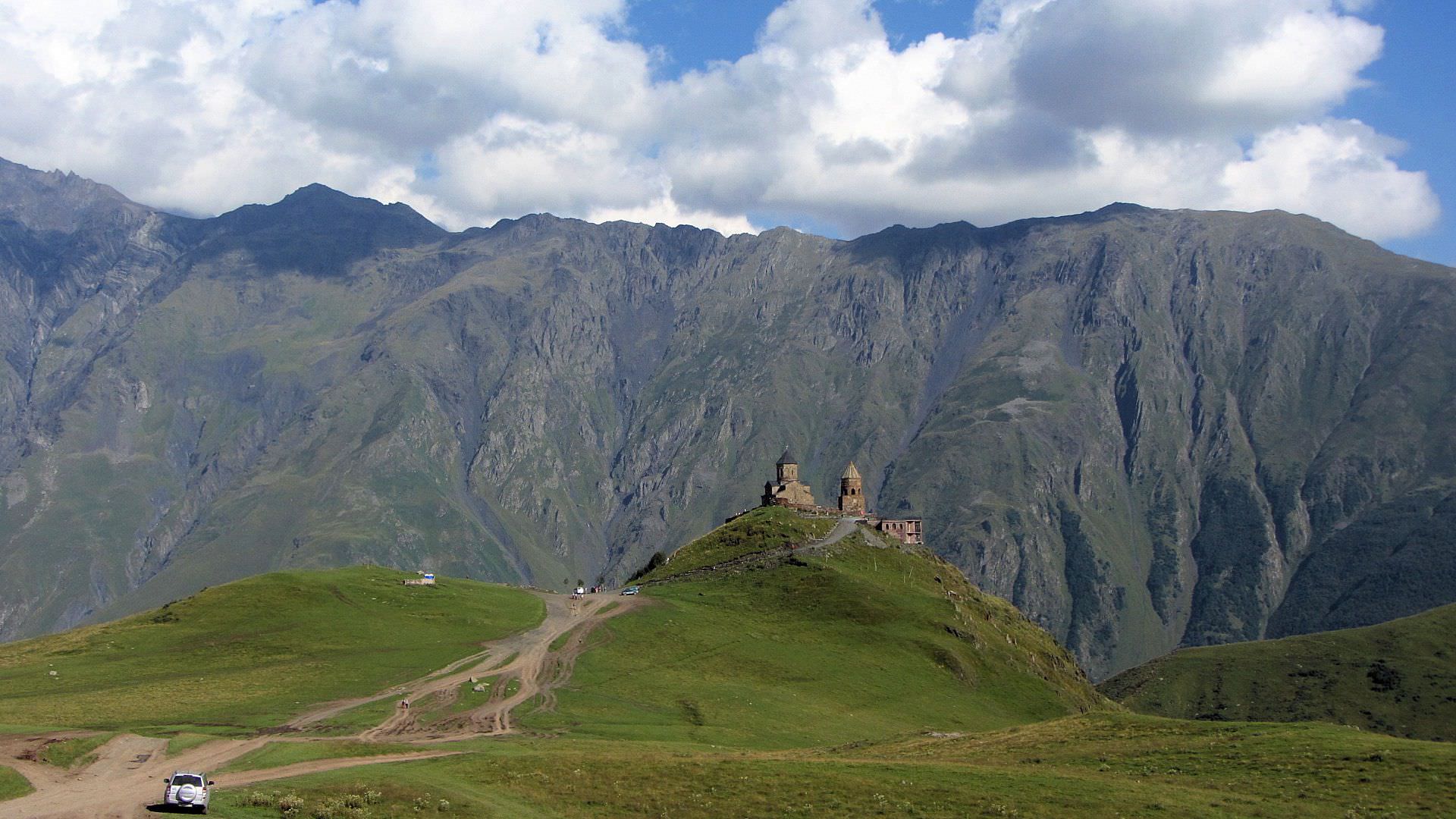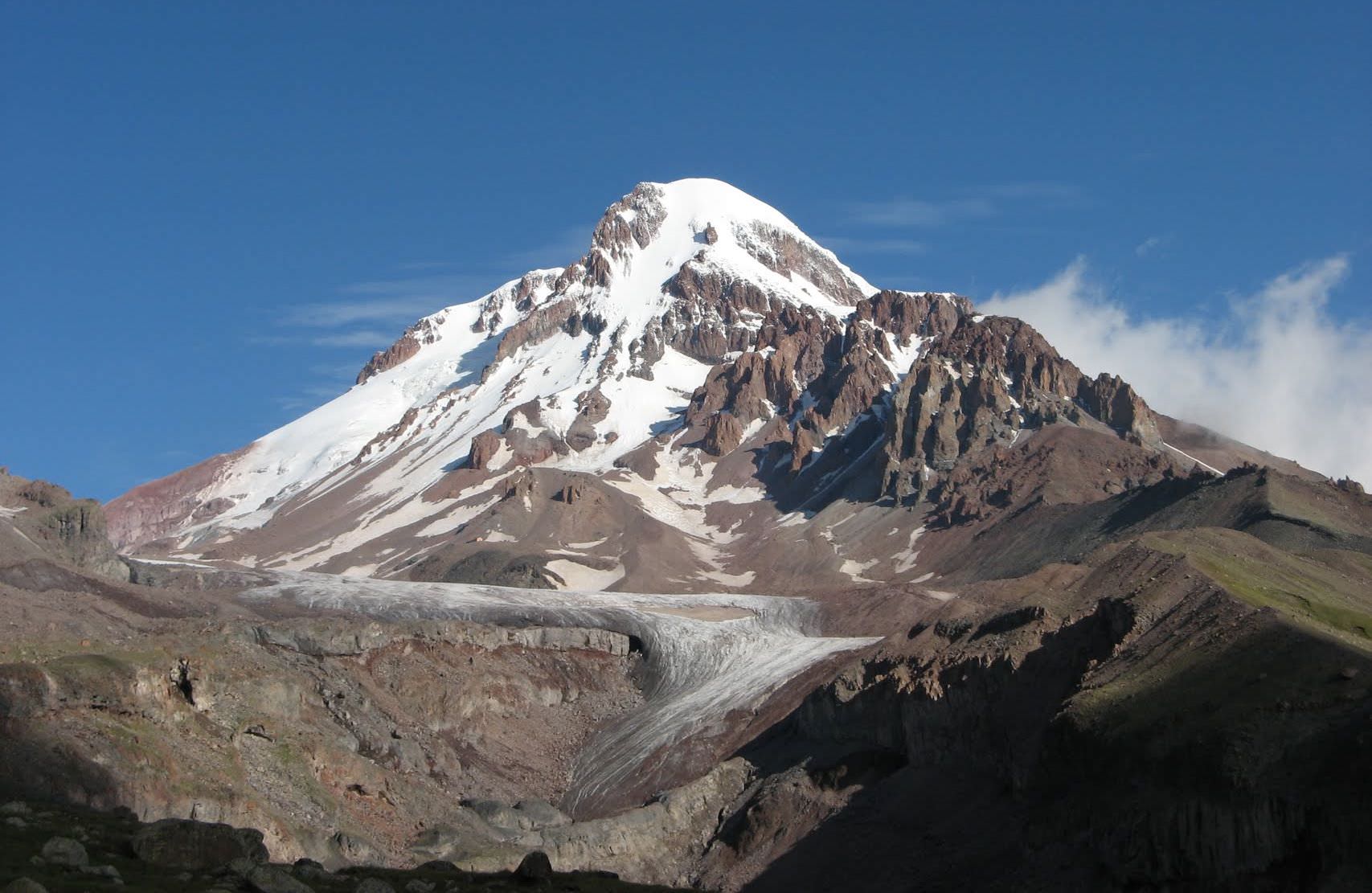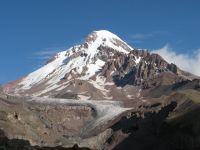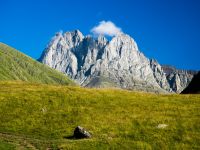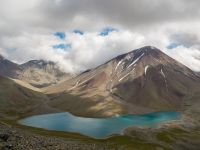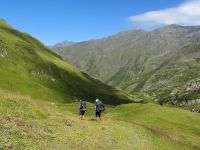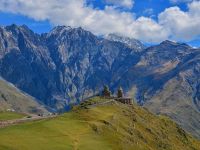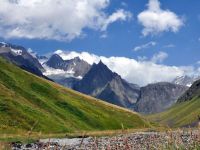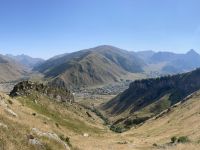- Home
- Regions
- Kazbegi
Kazbegi
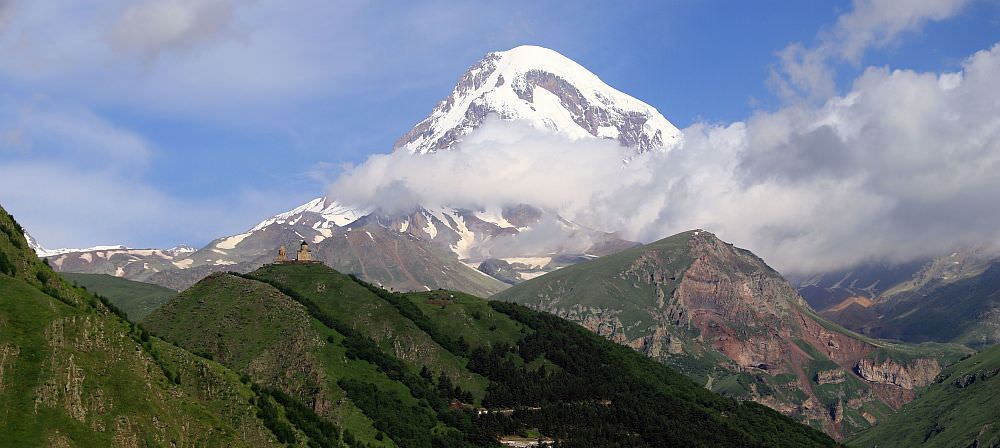
The picture of Mt. Kazbek seen from the windows will not easily be forgotten. Again and again it has been painted and photographed: it is met with in every book of travel, even in the shop -windows of St. Petersburg. It is the keepsake view — the Jungfrau from Interlaken— of the Caucasus.
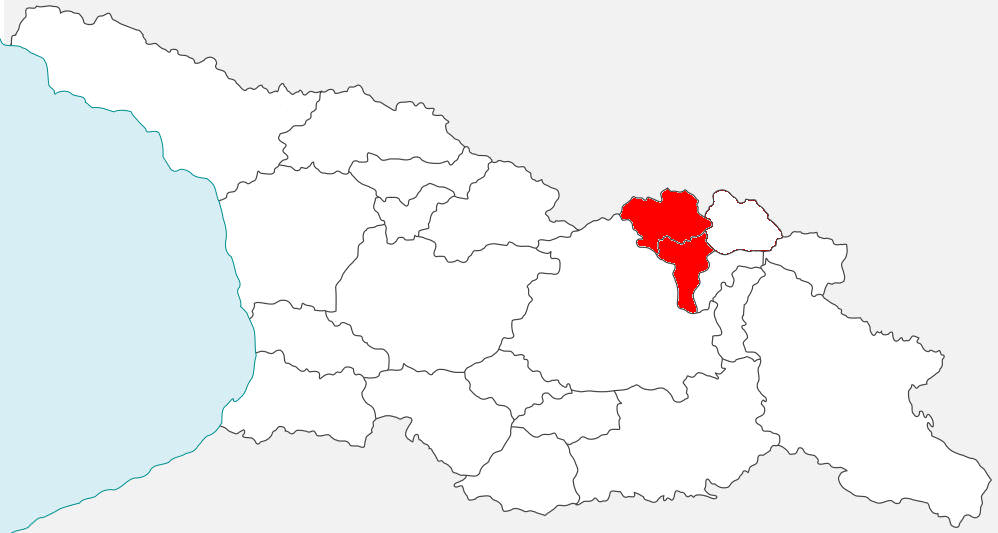
Kazbegi district lies in the Caucasus mountains north of Tbilisi, beneath the famous Mount Kazbek (5033m). Due to its combination of easy accessibility and natural beauty, it is the most visited mountain area in Georgia.
My relation with Kazbegi is interesting. I never considered it during the pre-trip planning, after all, it was "too touristy" (first visit) and "I´ve already been to the church" (next three visits). But then the reality hits me and I have to abandon some more daring plans in remoter regions. This leaves me with a few extra days which I often spend in Kazbegi region. And it never disappoints.
So, somehow, I think I´ve accumulated solid knowledge of the region. I summed it up below - hopefully, it will help you to make your visit as worthwhile as possible.
PRACTICAL INFO
- 1. Overview
- 2. Getting around
- 3. When to visit
- 4. Where to stay
- 5. What to eat
- 6. Things to do
- 7. Travel itineraries
UNDERSTAND KAZBEGI
- 8. History of Kazbegi
- 9. Local festivals
- 10. Local issues
1. OVERVIEW
First, let me explain naming to prevent further confusion. This guide covers the mountainous region known as Khevi, situated at the northern slopes of Greater Caucasus mountanis, north of Tbisili. Khevi (Georgian word for a "gorge") is formed by three large valleys - Tergi, Truso and Snostskali. Its center is Stepantsminda village.
So, why is this a "Kazbegi travel guide"? Mainly because that was the name of Stepantsminda village for last 200 years till it got renamed in 2006. But many people still use the word Kazbegi, it´s shorter, more convenient and resonates more (also thanks to the connection with Mt. Kazbek). No hustler at Didube station will offer you a "taxi to Stepantsminda" - because by the time he finishes, you will be sitting in the taxi to Kazbegi.
Term Khevi would be accurate, too, but it's little-known abroad and could cause confusion with neighbouring Khevsureti region.
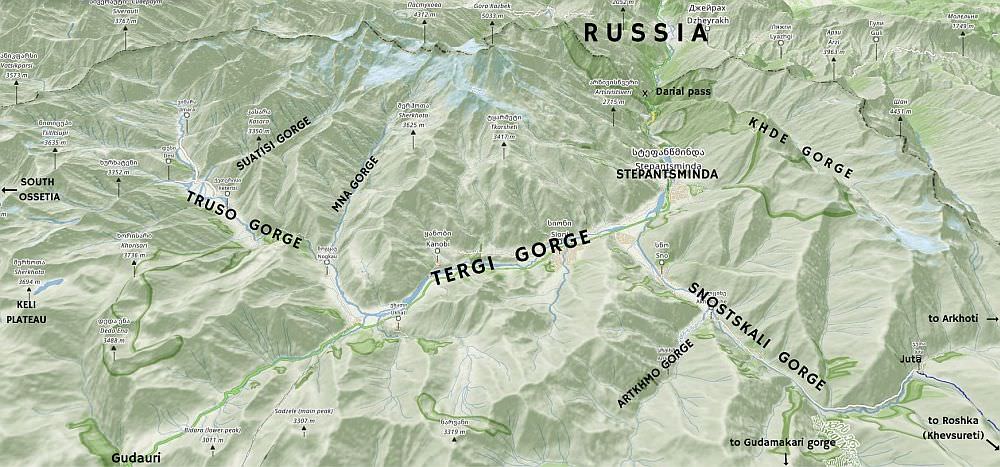
So, how to characterize Kazbegi? What sets it apart from other mountainous regions of Georgia? The answer presents itself - exposure to the world. While places such as Tusheti or Svaneti were essentially a backwater, Kazbegi always served as a strategically important gateway, because here led one of only two major routes connecting countries north and south of Caucasus mountains (the other being Derbent route in Russia which bypasses mountains from the east). This road was since antiquity used by merchants and invaders alike - everyone wanted to control the famous Dariali pass, "the key to the Caucasus". This led to the greater development of the region and construction of several beautiful churches and fortresses.
Of course, it has some drawbacks - Stepantsminda village is not some serene mountain hideaway (as some people expect it to be) but quite busy traffic hub. Georgian Military Road is often lined by trucks, slowly moving towards the Russian border. Still, it´s definitely worth a visit, treasuring several natural and architectural wonders. And if you look for serenity, you can find it in smaller side valleys.
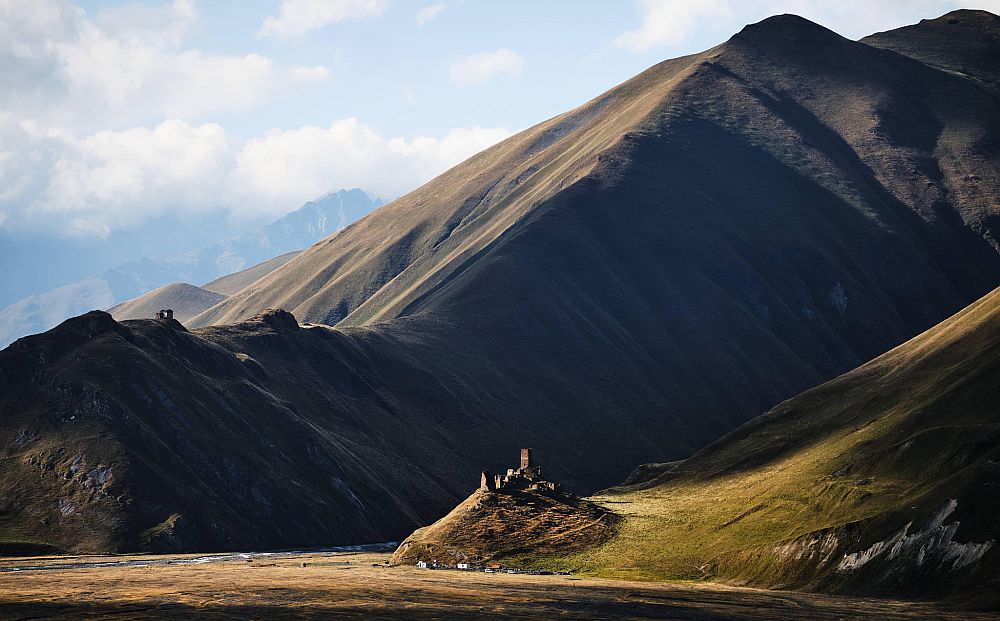
Ruins of Zakagori fortress in the Truso valley (by Niklas Eschenmoser)
2. GETTING AROUND KAZBEGI
How to get to Stepantsminda (Kazbegi):
The best place to start your trip to Kazbegi is the Didube bus station (located by the metro station of the same name). Here, you will need to decide if you want to take a marshrutka or a taxi.
Marshrutka
Cheapest and the least comfortable way to get to Kazbegi. These depart when full from 8. am till late afternoon. The ride costs 15 GEL and takes about 3 hours.There is one thing you need to consider - these are meant for locals, not tourists. That means that the driver doesn´t stop at any tourist hotspots along the Georgian Military Road. Instead, he will make only one break halfway, usually by some restaurant. So, as a first-time visitor, I would definitely forget about marshrutka and pay those few extra bucks for a taxi.
Shared taxi
While the seat in a shared taxi usually costs about 30 GEL, this mode of transport has many advantages. Car seats are larger, provide more legspace and better views (marshrutka windows are small, dirty and positioned too low so you often have to crawl to see the mountains outside). Also, the drivers stop at popular sights along the Georgian Military Road and give you enough time to explore.There are only a few things to consider - most drivers stop just at Ananuri fortress and Treaty of Georgievsk momunent so if you want something extra, better agree upon it beforehand. Also, it might be hard to find shared taxi which DOESN´T make breaks since these cater mostly to tourists.
Private taxi
If you travel in a group or money is not an issue for you, you can also hire a private taxi. Prices for the ride start at some 100-120 GEL, depending on the situation. Also, if you want to have everything planned in advance and prefer some proven driver, you could use gotrip.ge service, but expect to pay 140 GEL or more.
Georgian Military Road
Getting around Kazbegi
In Khevi, there is no public transport other than Tbilisi - Stepantsminda shuttles. As a result, tourists trying to visit remoter places had to hike rather expensive taxis.
Luckily, this has changed few years ago when Mountain Freaks agency introduced shuttle buses to most popular destination around Stepantsminda. These depart daily from their office during the season (April - October) as long as there are at least 3 people. Tickets are not particularly cheap, but overall, these shuttles are be very interesting for couples and solo travellers. Booking one day ahead is recommended - the bus has only 7 seats.
| Destination | Departure time | Return time | Price |
|---|---|---|---|
| Juta | 9:15 | 16:30 | 30 GEL |
| Truso valley | 9:15 | 16:45 | 30 GEL |
| Darial gorge | 12:30 | 15:30 | 30 GEL |
If these schedules don´t suit you or you are travelling in a larger group, a private taxi might be a better option. Prices can greatly vary and almost always can be haggles down. Here are prices which I think are more or less OK.
| Destination | One way | Return trip |
|---|---|---|
| Juta | 50 GEL | 80 - 100 GEL |
| Truso valley | 60 GEL | 80 - 100 GEL |
| Darial gorge | 20 GEL | 30 GEL |
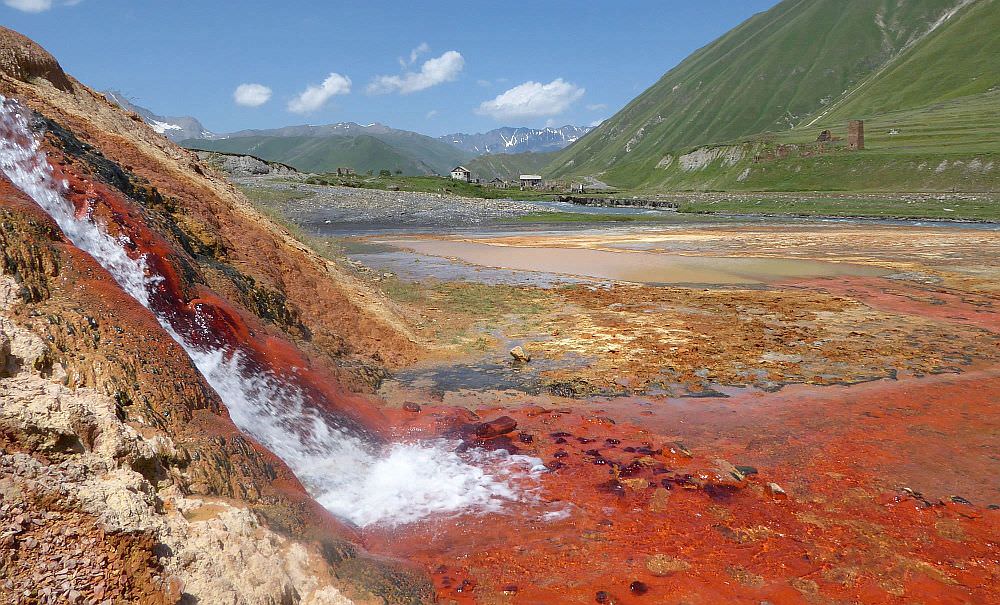
Mineral springs in Truso valley
How to leave Kazbegi
Leaving Stepantsminda is pretty straightforward. Marshrutkas to Tbilisi leave from the central square hourly between 7 am and 18 pm. If you can afford it, you can of course also hire a taxi - prices tend to be a bit lower than those in the opposite direction since many Tbilisi-based drivers service this route (we always drove for 80 - 100 GEL).
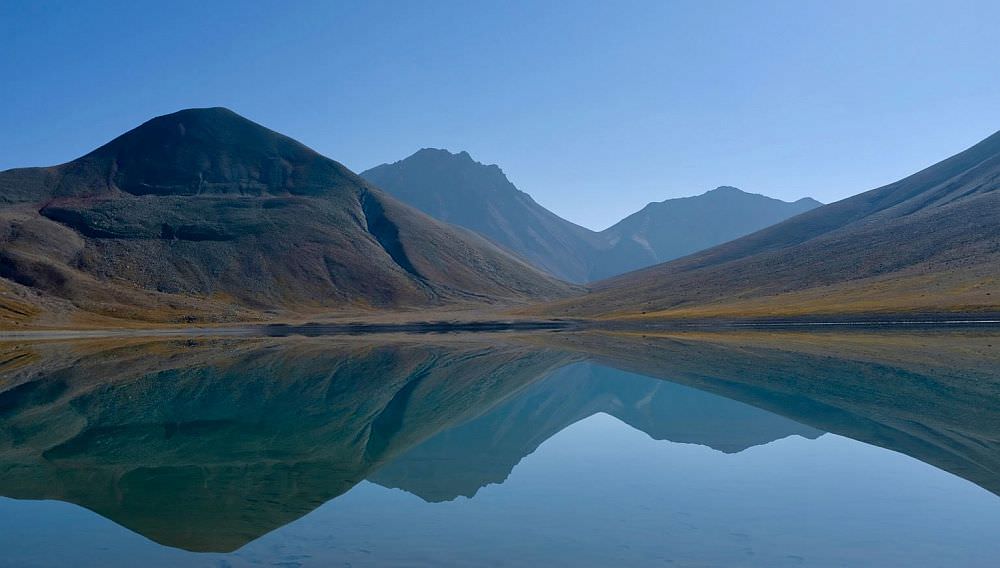
Keli Volcanic Plateau - little-visited corner of Khevi
3. WHEN TO VISIT KAZBEGI
Kazbegi region is accessible all year round - it has to be, due to the vital importance of the Georgian Military Road.
Skiing season (December - mid April)
During winter, everybody flocks to Gudauri, largest Georgian ski resort. Skiing season starts in mid December and lasts till April. Stepantsminda is accessible too, but there is not much to do there apart from seeing the church. Access to side valleys might be limited, Sno valley road might be blocked by snow and Truso valley is off-limits - border guards move their checkpoint close to the entrance of the valley and don´t let anyone through apart from experienced ski-touring groups with pre-arranged permits.
Spring season (April - May)
Not the best period if you are into hiking. Valleys are already accessible but one can do only easy hikes since the snowline starts around 2000m. Moreover, valleys are still grey and barren after winter.
Early summer (late May - June)
All trails with the exception of most difficult ones are already passable. Valleys are lush and green while mountains above are still covered with snow which creates interesting contrast. However, these periods belong to the rainier ones so to fully enjoy the scenery, you will need some luck with the weather. Also, the water level in rivers is generally higher due to the weather and showmelts which could cause problems on some treks.
High season (July - August)
All trails are open, number of people reach its peak (especially in August) - therefore, better book an accommodation in advance. Weather is already quite stable and suitable for hiking, days are long and warm.
Autumn season (September - mid October)
Days are shorter and colder. The scenery is not particularly colorful since everything is just drying up (and there are no major forests which would show some typical autumn foliage). Yet, hiking conditions are still very good - the weather is mostly dry, stable and you will have trails mostly for yourself.
Late autumn (late October - November)
Too late for some serious trekking, mountain passes already blocked with snow. Scenery is mostly brown and depressing, days short and often rainy. Go if you must, you will still have a good time, but you will be tempted to come again :)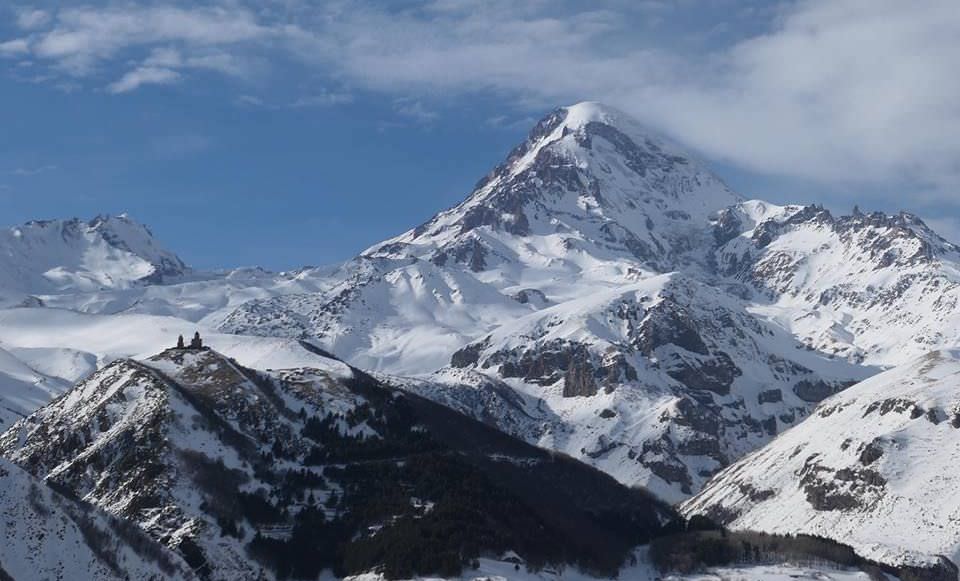
Mt. Kazbek in winter
4. WHERE TO STAY IN KAZBEGI
In Khevi region, the absolute majority of visitors stays in Stepantsminda village, mainly for logistical reasons (and also because it lies right beneath Mt. Kazbek). There are two other villages which provide wide range of accommodation. Juta village in Snostskali valley is popular during the summer. Gudauri ski resort has many hotels which get packed in winter and then mostly get closed once the snow melts. In past years, new guesthouses are popping up also in smaller villages along the Georgian Military Road such as Sioni or Arsha. Which is encouraging since it´s always better if the tourist money spreads and supports more villages. These places offer authentic accommodation with very few other tourists, but are not suitable for people without the car.
As for the accommodation in Stepansminda, there is Rooms Kazbegi - very expensive, upscale hotel with great reputation and then scores of guesthouses of varying quality. For many years, there was nothing in-between and even now is the offer of medium hotels extremely limited. Not that it bothers me that much, I stay at guesthouses and postpone Rooms visit until I visit with my wife. Of those I tried in past years, I can recommend two.
Qetino Marsagishvlili Guest House
Very pleasant, family-operated guesthouse close to the city center. Ran by the elderly couple and their daughter who speaks good English (they also have a very cute labrador). The main advantages of this guesthouse are tasty breakfast (costs extra 10 GEL), very reasonable price and comfortable beds.
Blue guesthouse
Another nice, family-operated guesthouse. It lies a bit away from the city center but is very easy to find since it´s really blue. Nino and her don´t speak English but communication is not a problem. Really liked comfortable beds, the views from the terrace (with blue railing), homemade wine and excellent breakfast.
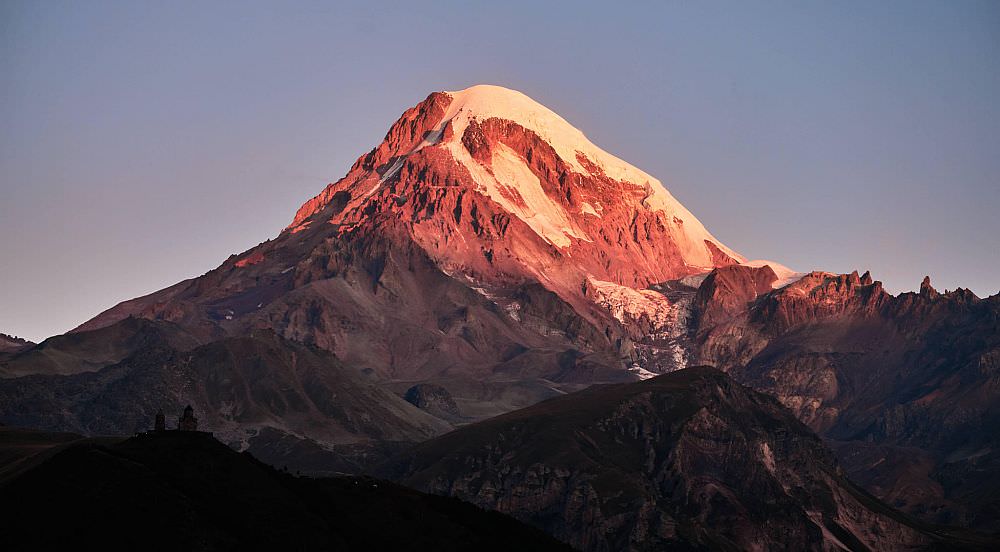
Mt. Kazbek in the morning - one has to spend a night in Stepantsminda to see it like this
Where to stay in Juta:
Finding an accommodation in Juta is easy. The village is already quite "guesthousified" and combined with the fact that the majority of people visit it only on a daytrip from Kazbegi means there are always some good places to choose from.
MetiTsa guesthouse - beautiful, modern place in the upper part of the village, on the way to the Chaukhi mountain. Nato is a great host, really attentive and caring - moreover, she is fluent also in English and Russian. Also, the food is plentiful and tasty, overall, this is one of the best places in Juta.
Levan & Megi's guesthouse - pleasant guesthouse located at the beginning of the village, down by the river. Rooms are not modern by any means but the place is very cozy and has welcoming owners who really care about the satisfaction of their guests. Moreover, Megi is an excellent cook and it shows each morning and evening :)
Fifth Season - a modern guesthouse/mountain hut lying above the Juta village. I am not exactly a fan, but this place cannot be overlooked since it has the best location in Juta with best views of the Chaukhi mountain. In my opinion, the place has an incredible potential but there is also lots of room for improvement.
It is not exactly the serene, calm place in the mountains as it looks to be. It has friendly, party atmosphere but staff is not always effective when it comes to enforcing the rules so earplugs are recommended. Also, they could turn down the volume of music they tend to blast into the valley. And the last but not least, they start serving breakfast only at 9 am. which is very inconvenient if you plan some longer trek such as crossing to Roshka.
Zeta camping - traditional camping place located above Juta village, on the way to the Chaukhi mountain. It offers accommodation in cottages as well as in tents - not a place for me since I always carry my own (and there are way nicer camping spots upper in the valley), but if you don´t have it and still want to camp in some beautiful location, this is a great (tho a bit expensive) pick. Also, the staff is very helpful and friendly. Overall, a very pleasant place.
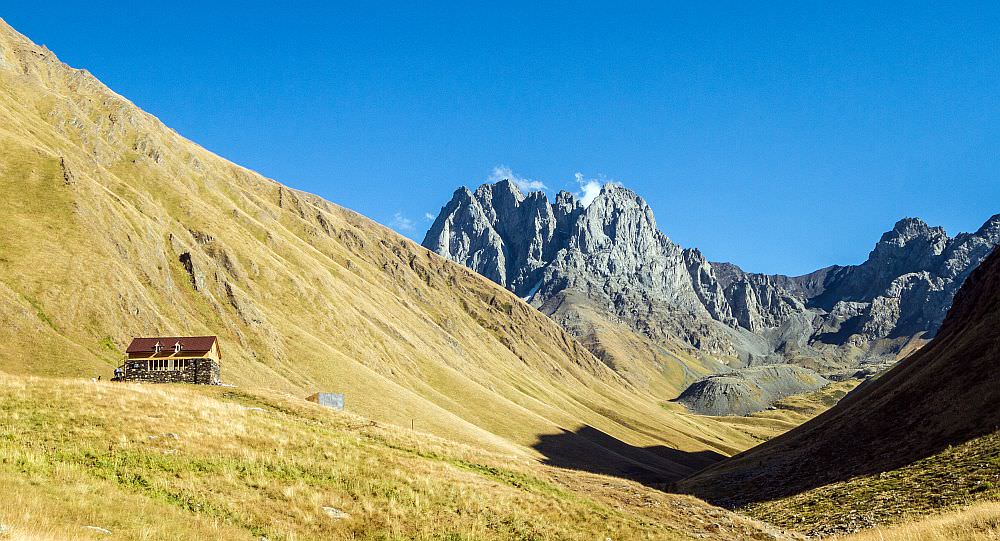
Fifth Season above Juta - there is a lot to improve about the hut but the view us perfect
5. WHAT TO EAT
As everywhere else, you have two options when it comes to eating in Stepantsminda - restaurants or guesthouses. Speaking of restaurants, there are many, but the quality varies. During out stay, there are two places where we usually end up.
If you want just to fill your stomach, I recommend Kazbegi Good Food situated a little below the main square. Nothing fancy, you sit outside on plastic chairs, but the food is tasty and prices, at least for Kazbegi standards, surprisingly low. They don't even try to rob tourists on beer, offer it for very friendly 3 GEL, while other restaurants usually charge twice as much. However, come a bit early if possible, place is small and tends to get full between 6 and 7 pm.
Another place I could recommend is Restaurant Cozy Corner. It is situated at the edge of the village, behind the Terek bridge, but still pretty close from the main square. Place is indeed cozy, warm and with nice wooden interior, an ideal place to stay during chilly evenings, have a chat with friend, eat some good food and drink a couple of 6GEL beers. Prices comparable with an average local restaurants.
Than there are two pretty famous restaurant, where I haven't been yet. One is situated at the Rooms Kazbegi Hotel and can be visited even if you are not staying at the hotel, The food is great but expect twice as much as in the usual restaurant. And then there is Tsanareti in Arsha village - large, traditional restaurant with great reputation. However, it is quite popular with tour groups so if you are unlucky, it may take a while till you will be served.
Another option is to order your breakfasts and dinners at the guesthouse where you are staying. Not all guesthouses provide this service, but if they do, it usually means much better value for money.
And which dish one should try while staying in Kazbegi? Definitely khinkali. While these dumplings can be found almost everywhere, Georgians agree that the best ones are made in villages along Georgian Military Road.
Already had your share of khinkali and would like to try something else? Check my post about Georgian cuisine.
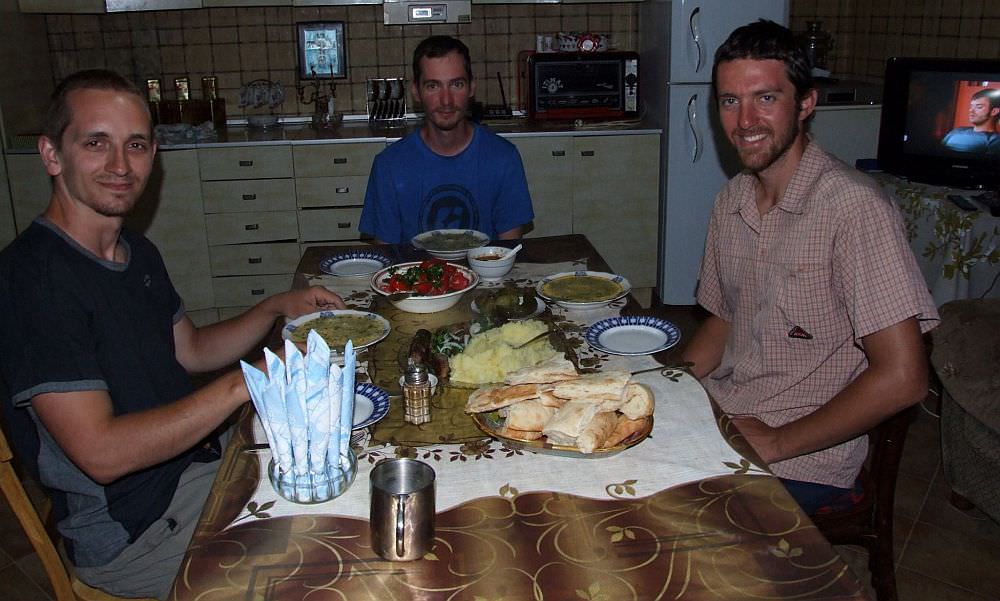
Homely atmosphere at the dinner in one of cheaper guesthouses
6. WHAT TO DO
Trekking and hiking
Many people come to Stepantsminda for hiking, but surprisingly, only a few trails start right at the village. True, there is
a famous trail to Tsminda Sameba church
and further up towards Mt. Kazbek, but that´s it. For some more hiking, you will have to visit side valleys.
The true hiking capital of Khevi is Juta in Snostskali gorge. The village is a starting point of numerous walks and treks of varying difficulty. Many tourists settle for an easy stroll in Chaukhi valley while hikers can trek east in direction of Khevsureti or Arkhoti, cross south into Gudamakari gorge or north to the Khde (Kistinka) valley. Or they can scale some non-technical accessible mountain such as Mukhadze (3280m) or Roshkakhorkhi (3562m).
Another great area for hiking is the Truso valley. Again, there is a simple walk at the bottom of the valley which is suitable for everyone as well as difficult treks which aim for Kelitsadi lake to the southeast or gorges of Suatisi and Mna to the north. There is also an option to cross from Mna to Tergi valley by the Sherkhota pass.
For more info, check the list of
best hikes around Stepantsminda (Kazbegi).
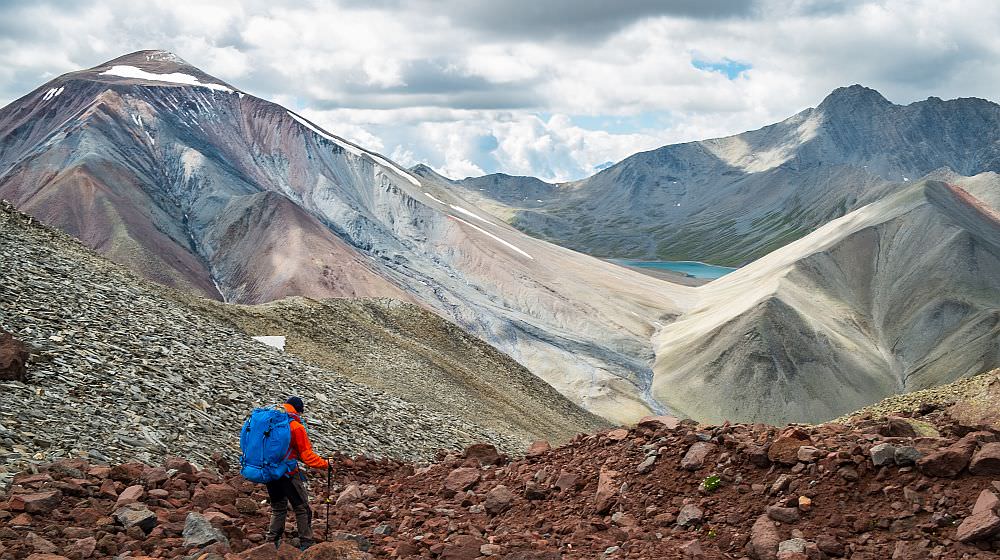
Trek to the Kelitsadi lake
Mountain biking
Kazbegi has some decent routes suitable for biking, but doesn´t offer as good conditions as neighbouring Tusheti and Khevsureti. The main reason is the density of traffic - Georgian Military Highway is a busy road with high ratio of ferries and trucks. Add the driving style of local drivers and I think it´s obvious that biking full lenght of GMH, no matter how good it looks on the map, is not a good idea. That leaves us only side valleys.
Valley most suitable for biking is Snostskali. A good plan for the day is to rent the bike in Stepantsminda (there are rental agencies at the central square) and bike to Juta and back. Just start a bit later, around 10 am to avoid jeeps. If you have your own bike and don´t mind hike-a-biking, you can continue east to Khevsureti. For this, pick the trail through Sadzele pass - it is much lower and not as steep as Chaukhi pass.
Another suitable valley is Truso - actually, it´s perfect since it´s almost flat. However, it lies much farther from Stepantsminda so you will need a car able to carry your bikes.
If you would like to try downhill, you should visit Gudauri - they are trying to turn the ski-resort into year-round destination and turn of their ski lifts also during summer months. So you can rent a bike there, ride to the altitude of 2700m and then ride 500 altitude meters down (there is currently one available trail). However, lovers of adrenaline may get more than they asked for - during summer months, shepherds are moving in with their herds and there were cases when their dogs went after speeding bikers.
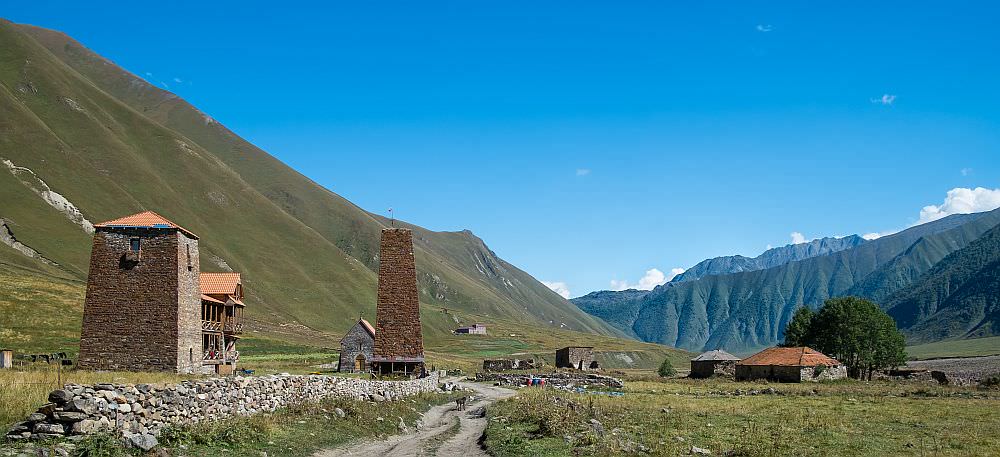
Truso valley is flat - an ideal destination for a daytrip on bikes
Horse-riding
Kazbegi region is not particularly known for horse tours, but there are some options. The most popular trail suitable for horse-riding follows the footpath climbing to Tsminda Sameba church. If you are interested, ask at your guesthouse - the price of the horse is just 50-60 GEL, but you will have to pay also your guide.Also, there is one thing you should know about. By default, many offered horse-tours don´t involve actual riding - you sit on the horse but the reins are held by a guide who walks in front of you. Which may be OK for someone and a letdown for someone else. So if you want to ride, make it clear - but it will be a bit more expensive cos your guide will need his own horse.
Paragliding
The best place to try paragliding in Kazbegi region is Gudauri. There are many instructors offering tandem flights, they start either from Treaty of Georgievsk monument or from various places around Gudauri resort. This pastime is not particularly cheap, it costs about 250-300 GEL for a 20-25 minutes long flight.
Just one word of warning - this business is unregulated and the quality of instructors greatly varies (I elaborate on it a bit more in Local issues section). So if you don't pick properly, you can easily stumble upon some local dude who recently bought a glider and isn´t properly qualified for tandem flights. As a result, there was one fatal accident. So I think it´s better to pick your paragliding agency in advance, based on reviews or other references. And even if you pick your instructor on the spot, make sure that he has a licence for tandem flights, ideally at least few years old. Reliable guys are from Georgian Paragliding Federation or there are several Ukrainian groups with very experienced fliers.
2022 update
Unfortunately, nothing improved over past years, quite the opposite. I know of at least two people who got killed due to amateur "instructors" in the summer of 2022 and after helicopter crashed while rescuing stranded paragliders, killing eight people aboard, paragliding in Gudauri was banned altogether. So, no flying for now, and that's for the better unless govt properly enforces rule that only experienced, licensed instructor can take a client on tandem flights - but I am somewhat sceptical about that :/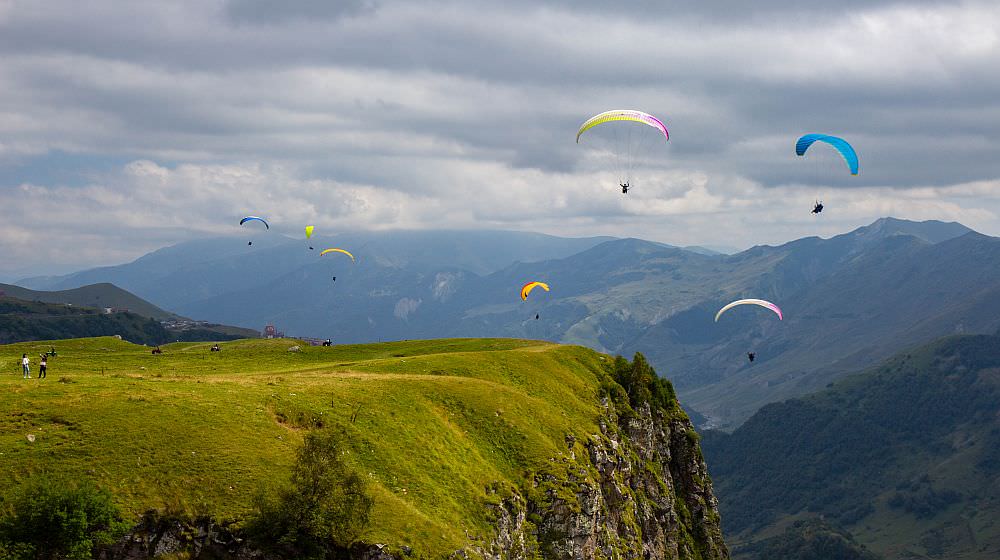
Paragliding at Gudauri
Skiing
Kazbegi region is a popular winter destination thanks to Gudauri - largest Georgian ski resort. It offers 15 ski lifts and 35 kilometers of maintained trails. And if that´s not enough, you can try heliskiing or backcountry skiing. Won´t get into more detail since skiing is not my area of expertise. But if you are interested in ski-touring trails around Gudauri, check Gudauri freeride guidebook.
Sightseeing
Khevi region is not just about sports, you can also visit many interesting places. In you are interested in stone towers, check neighboring Khada gorge - before the Georgian Military Road was built, the trade route crossing Caucasus went through here. The valley had as much as 60 towers - they mostly fell into disrepair once the place lost its importance after building of the GMR but some are still standing. Unlike towers elsewhere, these have a round footprint. Another tower stands in Sno village, but this one has a classic square footprint.There are also many other off the beaten track places you can visit. Not saying these are some world-class sights, but if you have some extra time, it could be nice to explore them - they may provide even better expperience than famous sites crowded with tourists.
- climb to St. Elias church above Rooms hotel for great views of Tsminda Sameba
- explore Sno village and take a photo with massive stone heads representing famous figures from Georgian history. Also learn the story behind them.
- visit ruins of Tamar´s fortress and newly built monastery in the Darial gorge
- climb from Gaiboteni to Toti village to check traditional Mokhevian towerhouses
- visit ancient churches in Garbani and Sioni
- check small ethnographic museum in Karchucha village
- make a trip to spectacular, almost abandoned village Tsdo. Above the village, there is an ancient place of animal sacrifices with an altar and ram statue
- soak in the mineral water at the Pansheti swimming pool
- climb to the secret cave above Sioni village

One of stone heads by the Sno village
Technical climbing
If you are interested in more technical climbing, you should check Chaukhi massif south of Juta village. There are numerous routes - classic ones range in difficulty between 2A and 6B rating but there is also a plenty of space for experimentation if you want to try something more difficult.Another good climbing destination is the vicinity of Gveleti waterfall. There are several established routes (6A-6B difficulty). Also, in winter, when the waterfall freezes, it turns into a very popular ice climbing destination.
And last but not least, there is nice wall with many routes by the Arsha village. Just cross the bridge to the western bank of Tergi river and turn right - you will see it soon. There are 30 climbing routes up to 40 meters high with difficulty ranging between 5a and 7b.
Mt. Kazbek climb
Mt. Kazbek is indisputably the most popular mountaineering summit in Georgia. The reason is simple - even though it boasts the status of "five-thousander", the climb is technically not difficult which is for many climbers an irressistible combination. It can be climbed also from the Russian side but since this route requires a permit, the absolute majority of climbers uses the Georgian side where the permit is not needed. The climb itself usually takes 3-4 days. I won´t write about it here since I am not a climber, but I strongly recommend you this post about the climb, I don´t think it´s possible to describe it in an even higher detail :)
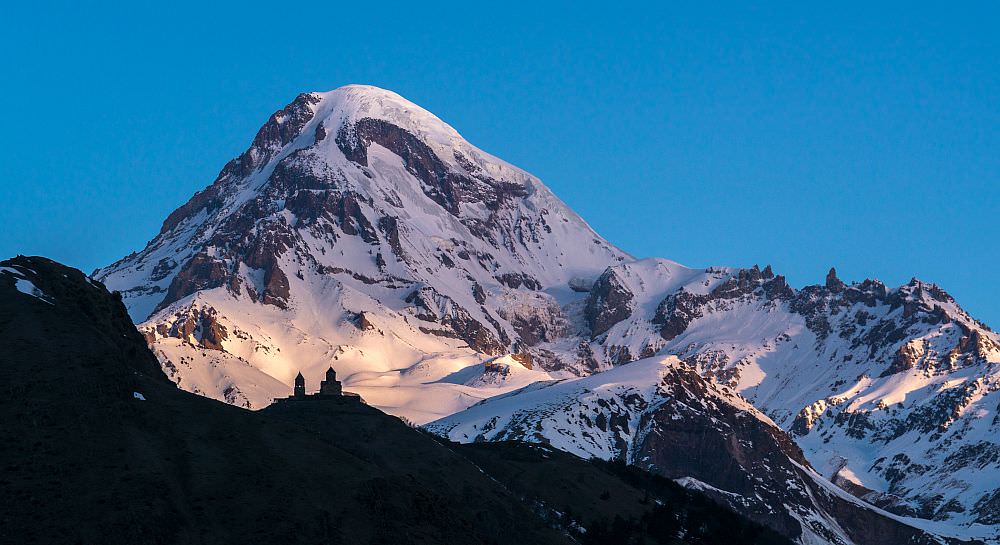
Mt. Kazbek
7. ITINERARIES
A few ideas how to spend your time in Kazbegi. First itinerary is made for "tourists" - people who don´t come to Kazbegi primarily to hike but are willing to stretch their legs a bit if it gets them to some nice places. These provide enough extra time for breaks, beer and eating. Other itineraries are for "hikers" who are fit and willing to hike a lot (but didn´t bring their camping gear) and "trekkers", who have tents.
TOURIST
3 days
Day 1: Arrival from Tbilisi, in the afternoon. Take a taxi to Darial Gorge, Tsdo village and Gveleti waterfall.Day 2: Take a taxi to Juta, stroll to the pub at the Chaukhi lake or even further into the valley. Return to Stepantsminda.
Day 3: Hike to Tsminda Sameba church before noon. Then return to Tbilisi.
Half-day program for days 1 and 3 can be exchanged depending on the weather. Hike to Tsminda Sameba needs good weather much more than a visit of Darial gorge and Gveleti waterfal..
5 days
Day 1: Arrival from Tbilisi. Visit of Dariali gorge, Tsdo and Gveleti waterfalls .Day 2: Hike to the Gergeti glacier.
Day 3: Hike in the Truso valley.
Day 4: Taxi to Juta, crossing to Roshka through the Chaukhi pass . Night in Roshka.
Day 5: Return to Juta through the Sadzele pass. Taxi back to Kazbegi
Day 5: (alternative) Don´t return to Juta but take a morning bus from Barisakho to return to Tbilisi.
TREKKER
3 days
Day 1: Arrival from Tbilisi. Visit of Dariali gorge, Tsdo and Gveleti waterfalls .Day 2: Hike to the Gergeti glacier (or even to the Betlemi hut) and back to Stepantsminda.
Days 3-5: Multiday trek in the area. Recommended is the trek to the Kelitsadi lake , but considered can be also Suatisi gorge or the crossing of Kibishi pass .
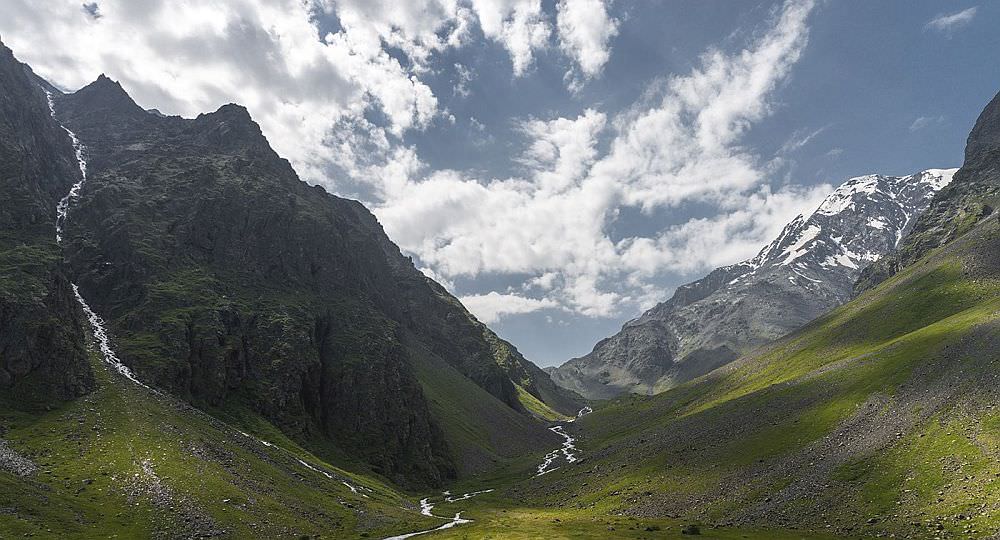
Khde (Kistinka) gorge
8. HISTORY OF KHEVI
Khevi region has been inhabited since antiquity. It was first mentioned by Ptolemy as Zanarioi - "the land of Tsanars". The origin of Tsanars is not clear but most scholars agree that they were one of original Nakh tribes of the northern Caucasus.
For many years, Tsanars controlled an ancient trade route, the only one going through the Caucasus. It was both blessing and a curse since the route brought not only prosperity, but attracted also invaders - Persians, Romans, Alexander the Great, Romans, they all sent their armies through. And when eastern Georgian fell to Arabs, Tsanareti Khevi ('Tsanar Gorge') became one of major battlefields of Arab-Khazar wars.
For a time, Tsanareti was controlled by Arabs but the region was hard to control due to repeated rebellions. And when Arab´s power in Georgia waned, Tsanars ventured even south to Kakheti and supported locals in their fight for independence. Over those years, they mingled heavily with Georgians and accepted their language, culture and religion. As a result, they ceased to exist as a distinct tribe and became part of Mokhevians ("people of Khevi"), one of Georgian ethnographic groups.
During the Golden age of Georgia kingdom between 11 - 13 century, people of Khevi served as guardians of northern approaches. They were not integrated into feudal system and maintained the high degree of independence - they were ruled by "khevisberis" ('elders of the gorge'), elected by their communities. This setup worked quite fine till 17th century when Khevi found itself under increasing pressure from dukes of Eristavi and temporarily fell under their control.

Tsminda Sameba church, built in 14th century
At the end of 18th century, Georgian king Erekle II. appointed a new bailiff responsible for collecting taxes from passing caravans. This task fell upon Kazi-Beg, leader of the influential local clan. In next years, clan rose to even greater prominence. When Mokhevians revolted after Georgia got absorbed by Russia, Kazi-Beg's son Gabriel Chopikashvili stayed loyal to Russians and helped to quell the uprising. As a reward, he got a position in Russian army (made it to major) and a chance to run Khevi as his fiefdom. He also changed his name to Kazbegi.
Gabriel's son Mikheil was even more successful - he distinguished himself in wars with Caucasian Imamate and rose to the rank of general. His son, Alexander Kazbegi, seeing that he won't be able to outrank his father chose a different career path and became a very succesful writer.
During this period was built also Georgian Military Road - in 1801, tzar Alexander I. decided that Russia needed fast and reliable route to Transcaucasia. The work didn´t go well, so in 1816, he appointed general Alexander Yermolov to the region. This cruel but effective soldier managed to build the road through Khevi - to this day, on Jvari pass can be found the cross he ordered to place there. At this period, Kazbegi became the Russian "Wild West" where young Russian officers travelling to find fortune and glory. Many of these officers such as Pushkin, Tolstoy or Lermontov became famous writers. And romantic visions of unconquered mountains and proud, honorable tribes and their contrast to "civilized people" strongly influenced their later works.
After the Russian revolution in 1917, Georgia gained the temporary independence. But once the Soviets managed to win the civil war, they sent their army to reconquer seceded regions. Mokhevians gave strong resistance but all was in vain since the bulk of Red Army bypassed Caucasus and invaded Georgia from Azerbaijan.
During the Soviet period, the region remained under tight control because of the military road. Beyond the road, another source of income appeared - tourism. Khevi became a popular destination for Soviet mountaineers. After the dissolution of Soviet Union came the era of chaos but thanks to good accessibility, Khevi recovered faster than other places. Finally, in 2013 was reopened the border with Russia and trucks and touirsts started flowing in - thanks to this and overall tourist boom in Georgia, Khevi sees as many tourists as never before.
9. LOCAL FESTIVALS
Lomisoba
Lomisoba is the most important religious festival in the Eastern Caucasus. It takes place on seventh Wednesday after the Easter at Lomisa church, situated at the top of the mountain ridge some 10 km south of Gudauri. The access is not easy - there is no road so, in order to reach the church, one has to walk good two hours. Yet, thousands of pilgrims attend each year.
Lomisoba festival is devoted to St. George but has strong pagan roots. It is known for animal sacrifices - hundreds of sheep are killed at the spot each year. This practice is getting under growing pressure from both Church and activists, but locals are holding on.
There are numerous legends tied to the Lomisa church. Church itself is named after an ox Loma which carried the icon of st. George - his divine intervention allowed 7000 Georgian to return from Khwarezmian captivity and Loma guided them of their way home. The church was built on the place where the ox fell. Another legend mentioned soldiers which chopped the church door for firewood and all got blind. Their eyesight got restored only after they donated a new, iron door (preserved on the church till present days). Here is also an old, 60kg iron chain with a neckstrap brought to Lomisa by Dadiani nobles from Samegrelo. Pilgrims who want to place a wish or appeal to St. George put it around their necks and walk around the church three times counterclockwise.
According to another legend, there is a door south of the church and the key lies to the north. So the festival cannot start unless there are people from both sides participating. This legend got a new meaning after Russia occupied Akhalgori district during 2008 war and Lomisa church suddenly found it self right at the demarcation line. Yet, the festival continues - at this occasion, Russian guards grungingly let Georgians from both sides oft he border to meet and mingle.

Lomisoba festival
10. LOCAL ISSUES
Foreigners stealing our jobs!
The story is always the same. First is the visit from some country with developed tourist infrastructure. Tourist sees an untapped potential at some location, moves in, build a business and thanks to the hard work and systematic approach, builds himself a strong position. Few years later, locals take a notice and decide to compete. But it´s not easy - the market is already controlled by foreigners. How dare they??
This happened all over Georgia - such cases can be seen in Svaneti, Tusheti or Kazbegi. Heck, I even heard that one of the largest trekking websites about Georgia is ran by some Slovak (!) guy. But nowhere are the tensions greater than in Gudauri.
What happened? Some 20 years ago, Gudauri was "discovered" by Ukrainian paragliders. They liked the flying conditions and ease of doing business and eventually founded several companies offering flights for tourists. Over years, also Georgian flies moved in and started offering their service, but the competition was still not that strong.
That changed in 2017. People from neighbouring villages decided that they also want their share, bought gliders and learned to fly. Almost overnight, dozens of new "flight instructors" appeared on the site. This led to many conflicts. Ukrainian groups tried to make police to ban local fliers, arguing that aren´t property trained and pose a threat to tourists. Fliers from surrounding villages, on the other hand, tried to get rid of foreign (and also of some Georgians from other regions) fliers arguing that this was their territory and only they had right to do the business there.
The situation escalated in June 2017 when a large group of Georgian fliers attacked basecamp of one Ukrainian company and beaten several people there. Several people ended up with assault charges. Since then, the situation looks calm but there is still a lots of animosity between various flying groups.
2002 update: Sadly, no improvement, quite the opposite. After paragliding at Gudauri got baned due to several fatal incidents involving inexperienced fliers, locals expanded their portfolio and now are harassing foreign ski instructors as well :/
Roads, roads everywhere!
Georgian government is planning to build two new roads in Khevi regions. Both projects raise some concerns - while there are indisputable benefits, many people are worried that the government is not doing enough to mitigate related risks.
The first one is a new road connecting Kvesheti and Kobi, villages on Georgian Military Road. This road would bypass both Gudauri and Jvari pass. Instead, 9 km long tunnel will be build through the main ridge of the Greater Caucasus, which will save some 30 minutes of driving time.
So far so good, but there are also some critics. The road will navigate through the Khada gorge, sparsely populated valley east of Georgian Military Road. And locals aren´t particularly excited by the idea of highway going through their backyard. Major highway, with it´s bridges and viaducts would reshape the valley and damage its (yet untapped) touristic potential. Also, construction would demand the resettlement of dozens of families. Locals don´t question benefit of the road, but point out that there were several proposed routes which weren´t that much different when it comes to costs and travel time saved. And the government chose the one which affects Khada valley the most, as if it didn´t take environmentnal issues at all into account. So there were already several protests and online initiatives.
Second road should replace the current hiking trail going from Juta to Roshka through the Sadzele pass - the main reason is to open neighboring Khevsureti region to mass tourism. The road itself will pass though national park which slowed the road construction, some permits are still missing. But I think they will build the road anyway, the temptation is too strong and the distance is quite short. They already started chipping behind Juta, permit or no permit. If you would like to know more, here is the page of the initiative opposing it (mostly oriented on stopping much more damaging Shatili - Omalo road, but this road is also part of that project).
There is also another road project, but this one is already finished - in past year, a new, concrete road was built to Tsminda Sameba church. In this case, noone protested, maybe with the exception of local taxi drivers. But looking at the dozens of cars around the church, one has to wonder if that cable car built by Soviets wasn't a better option after all. This cable car was destroyed pretty soon, officially by locals who feared against desecration of the holy place. But seeing today's reality, I wonder if it wasn't work of those local taxi drivers.. :)
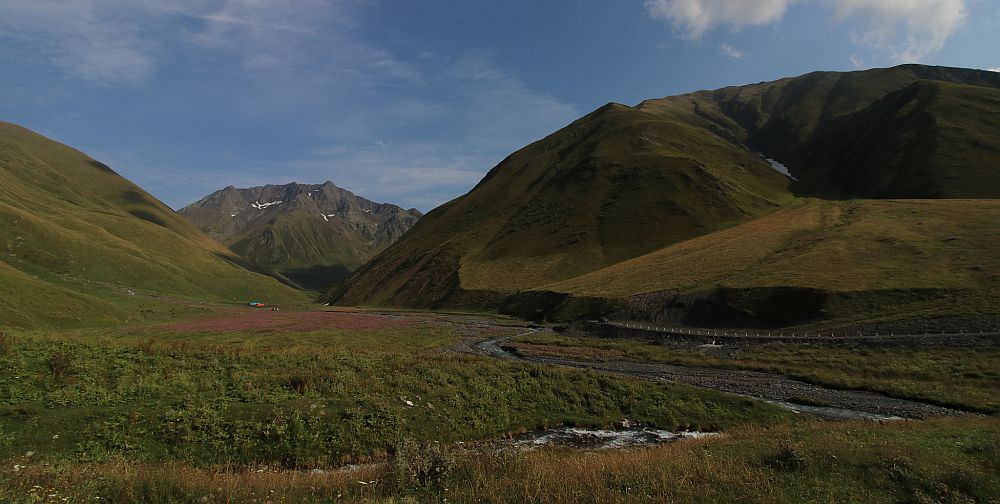
Unfinished road beyond Juta
Thank you for reading all the way down here, I know it wasn't easy :). If you think I overlooked something important or made some other mistake, please let me know. And if you enjoyed it and are into trekking, hiking or Caucasus, you can name your firstborn share it or like my Fb page. Or subscribe to the newsletter.
Mount Kazbek
Mount Kazbek ( Mkinvartsveri in Georgian) is a 5033m high, dormant stratovolcano lying north of Tbilisi, at the border with Russia. It is the third highest mountain of Georgia, towering 1000 meters high above it's neighbours. The mountain always evoked respect also played an important role in the Georgian mythology. It was a place of imprisonment of a mythical hero Amirani, who bears many similarities with Greek Prometheus. Because of this, the mountain is often referred to as a place where Prometheus himself was chained (Greek legend doesn´t specify the place, says only it was in the Caucasus).
The another legend is tied to the mythical cave monastery Betlemi. Established in 6th century in a cave hidden in a rock wall 80m above the ground at the elevation of 3800m, it was the most inaccessible monastery in Georgia (and that really means something!). The monks had to climb the iron chain to get inside. According to "Life of Kartli's Kings" chronicle, during the Mongol invasion, a unit of young soldiers hurried here to hide the royal and church treasures. And once the treasure was at a safe place, they killed each other to keep a secret. And they did an exceptionally good job - the monastery was hidden so well that it was rediscovered only during Second World War. Inside were find various coins, books and other antiquities (but no royal treasure). The iron door which once protected the entrance is now on display in the museum in Stepantsminda.
OK, enough history for now :). Even though the Kazbek boasts the status of "five-thousander", the climb is technically not difficult - these are the main reasons why it´s a very popular mountaineering summit. It can be climbed also from the Russian side but since this route requires a permit, the absilute majority of climbers uses the Georgian side where the permit is not necessary. The climb itself usually takes 3-4 days. I won´t write about it here since I am not a climber, but I strongly recommend you this post about the climb, I don´t think it´s posible to describe it in an even higher detail :)

Mount Kazbek
Ananuri fortress
Ananuri is scenic castle complex lying by the Georgian Military Highway, right at the bank of Zhinvali water reservoir. It is a popular stop of tourists travelling to Kazbegi.
Fortress was built by eristavis (dukes) of Aragvi , its oldest sections date back to 13th century. In 1739 was Ananuri attacked by rival duchy and Aragvi clan got massacred.
Four year later local peasants stood up agains the usurpers, killed them and invited Kakhetian king Teimuraz II. to rule over them. Fortress remained in use till 19. century.
Castle consists of two fortifications joined by a wall. Upper fortification is well-preserved, within it are two richly decorated churches.
In the past few years, it is possible to notice creeping development of the site. True, the entrance is still free and toilets are still horrible, but the parking spot in front of the fortress
is not covered by numerous merchant stalls. Also, nice viewpoint above the Zhinvali reservoir got sealed off by the iron gate.
On the positive note, I think several straiways and wooden ceilings were reconstructed so it's possible to explore previously unaccesible areas.
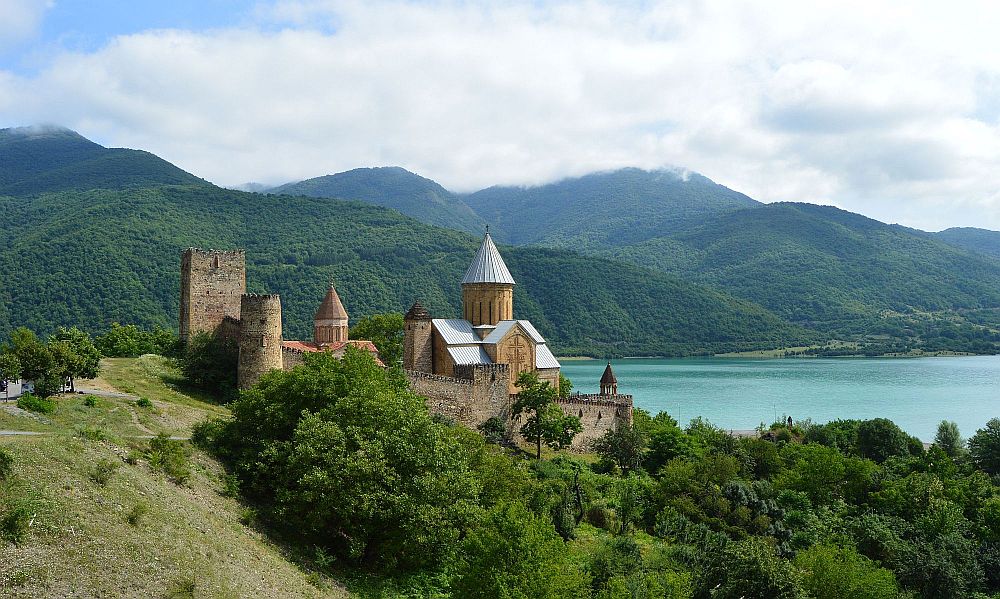
Ananuri fortress
Memorial of Russo-Georgian friendship
Another popular stop of tourists heading to Kazbegi village, this memorial lies on Georgian Military highway in Gudauri, close to the Jvari pass.
It was built by Soviets on 1983 to commemorate 100 years of common existence of both nations.
Memorial has a form of lange concrete semicircle decorated with scenes from Georgian and Russian history.
It is built on a ledge overlooking the valley and offers superb views of surrounding mountains.
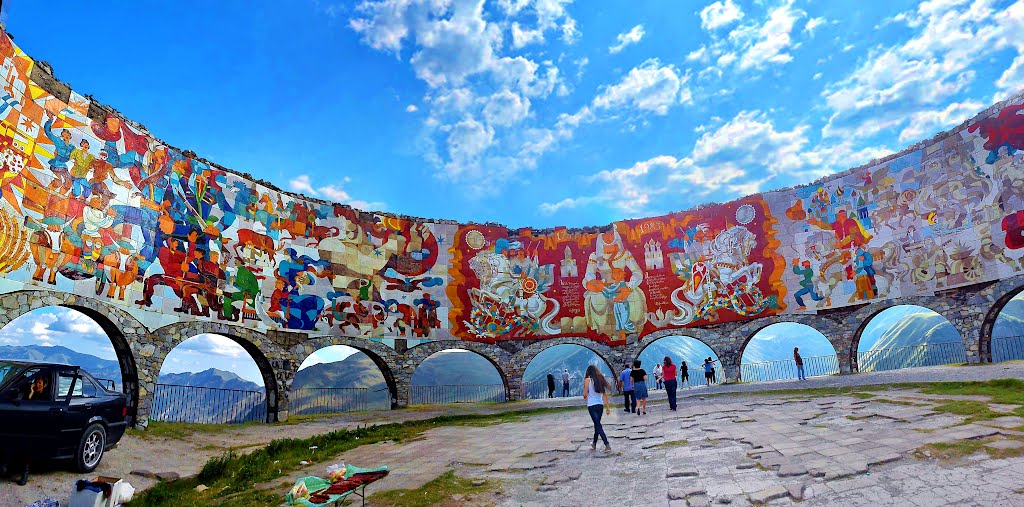
Memorial of Russo-Georgian friendship
Tsminds Sameba church
Georgians are well known for their habit of building churches on scenic, elevated places and this old shrine is the finest example.
Tsminda Sameba (Gergeti Trinity) church lies on a top of the hill which is a part of Kazbegi massif, 3rd highest mountain in Georgia.
Church was built in 14th century and consists of actual church and separate belltower. Its isolated location in the heart of mountains made it a symbol of Georgia.
During the invasion of Persians in 18th century it served as a depository of precious Georgian relics from Mtskheta such as St. Nino’s cross.
During the Soviet era religious services were prohibited, but government realized the appeal of this destination and built a ropeway to it.
Locals, however, opposed this act of defilement and promptly tore it down. Nowadays is the church active establishment of Georgian Orthodox Church.
Church is one of the most famous sights in Georgia, it can be reached by 1,5 hours long walk form Stepanstsminda village.
I am not too religious but this place has really special atmosphere - its small, but one can really feel how old and sacred it is.
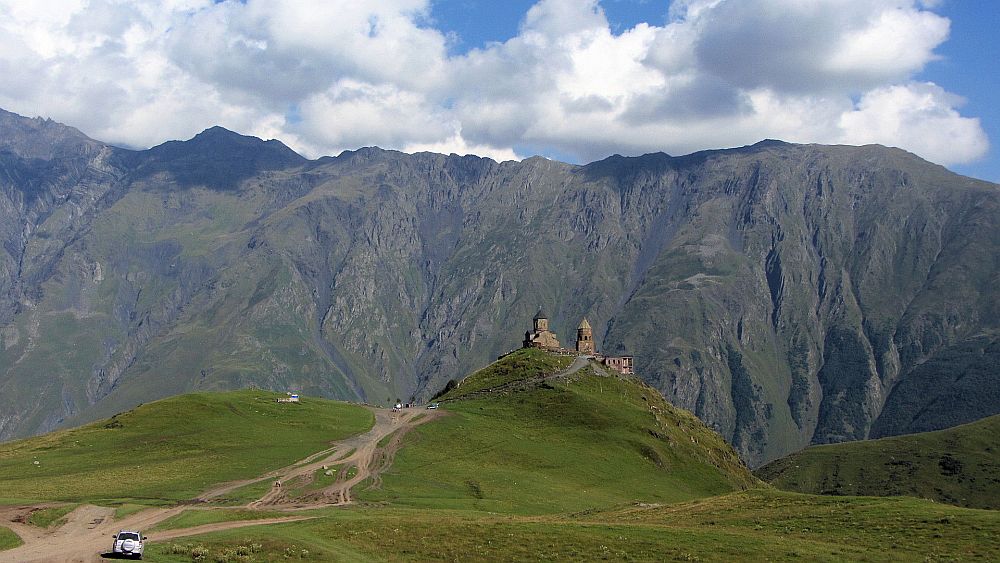
Tsminda Sameba church
From Kazbegi village to Gergeti glacier
Nice dayhike from Kazbegi village to the foot of Gergeti glacier covering Mt. Kazbek at the elevation of 3200 meters. On the way you will pass beautifuly situated Gergeti Trinity church, probably the most famous Georgian landmark.
- Duration: 1 Day
-
Difficulty: Hard
Basic level
Lorem ipsum dolor sit amet, has at illum dictas definitiones, ei primis indoctum torquatos nec. Vis te velit probatus, natum atomorum tincidunt nec an.
From Juta to Roshka via Chaukhi pas
Well-known Georgian trail connecting Kazbegi region with Khevsureti. It very interesting due to proximity of imposing Chaukhi massif with its seven sharp peaks and necessity to scale 3341 meters high Chaukhi pass.
- Duration: 1 Day
-
Difficulty: Hard
Basic level
Lorem ipsum dolor sit amet, has at illum dictas definitiones, ei primis indoctum torquatos nec. Vis te velit probatus, natum atomorum tincidunt nec an.
The walk in Truso valley
Walking in Kazbegi area in almost abandoned valley in direction of South Ossetia borders. Nice nature, interesting travertine formations.
- Duration: 1 Day
-
Difficulty: Moderate
Basic level
Lorem ipsum dolor sit amet, has at illum dictas definitiones, ei primis indoctum torquatos nec. Vis te velit probatus, natum atomorum tincidunt nec an.
From Roshka to Juta by Sadzele pass
Alternative, less demanding hiking trail connecting Juta village with Roshka which crosses 3060m high Sadzele pass.
- Duration: 1 Day
-
Difficulty: Moderate
Basic level
Lorem ipsum dolor sit amet, has at illum dictas definitiones, ei primis indoctum torquatos nec. Vis te velit probatus, natum atomorum tincidunt nec an.
Trek to Kelitsadi lake
This trek, starting in picturesque Truso valley, explores the Keli volcanic plateau, barren, rocky piece of land lying west of Georgian Military Highway. It crosses two 3400m high mountain passes and visits remote Kelitsadi lake.
- Duration: 3 Days
-
Difficulty: Hard
Basic level
Lorem ipsum dolor sit amet, has at illum dictas definitiones, ei primis indoctum torquatos nec. Vis te velit probatus, natum atomorum tincidunt nec an.
From Juta to Roshka via Arkhoti valley
Another great 2-day trek from Juta to Roshka, less frequented that classic Chaukhi route. It crosses two mountain passes and wild Arkhoti valley.
- Duration: 2 Days
-
Difficulty: Moderate
Basic level
Lorem ipsum dolor sit amet, has at illum dictas definitiones, ei primis indoctum torquatos nec. Vis te velit probatus, natum atomorum tincidunt nec an.
From Shatili to Juta through Isirtghele pass
Very demanding 6-day trek connecting Shatili, historical center of Khevsureti with Kazbegi region. Crosses two mountain passes and leads through little visited border areas of Georgia
- Duration: 4-5 Days
-
Difficulty: Very hard
Basic level
Lorem ipsum dolor sit amet, has at illum dictas definitiones, ei primis indoctum torquatos nec. Vis te velit probatus, natum atomorum tincidunt nec an.
Hike from Arsha to the Gergeti glacier
An alternative, little-known route to the popular Gergeti glacier that starts at the Arsha village, crosses Arsha pass and joins the classic trail a little below the glacier.
- Duration: 8-9 Hours
-
Difficulty: Hard
Basic level
Lorem ipsum dolor sit amet, has at illum dictas definitiones, ei primis indoctum torquatos nec. Vis te velit probatus, natum atomorum tincidunt nec an.
Walk to the Gveleti waterfalls
Simple stroll to the couple of a nice waterfalls lying at the both ends of forked Gveleti valley.
- Duration: 1 Hour
-
Difficulty: Very easy
Basic level
Lorem ipsum dolor sit amet, has at illum dictas definitiones, ei primis indoctum torquatos nec. Vis te velit probatus, natum atomorum tincidunt nec an.
Hike to the Gergeti Trinity church
A straighforward hike to probably the most iconic Georgian landmark.
- Duration: 3-4 Hours
-
Difficulty: Easy
Basic level
Lorem ipsum dolor sit amet, has at illum dictas definitiones, ei primis indoctum torquatos nec. Vis te velit probatus, natum atomorum tincidunt nec an.
Hike in the Artkhmo gorge
Hike start in Akhaltsikhe village in Sno valley and heads south, following the Artkhmo river. On the way you can see deserted village Artkhmo as well as several small waterfalls.
- Duration: 3 Hours
-
Difficulty: Easy
Basic level
Lorem ipsum dolor sit amet, has at illum dictas definitiones, ei primis indoctum torquatos nec. Vis te velit probatus, natum atomorum tincidunt nec an.
Crossing Khde gorge to Juta
Trail connects Darial gorge with Juta village. It crosses beautiful, wild Khde valley with several waterfalls and offers great views from 3500m high Kibishi pass. Glacier equipment needed!
- Duration: 3 days
-
Difficulty: Very hard
Basic level
Lorem ipsum dolor sit amet, has at illum dictas definitiones, ei primis indoctum torquatos nec. Vis te velit probatus, natum atomorum tincidunt nec an.
Crossing from Suatisi to Mna valley
This nice trek explores little-visited valleys of Suatisi and Mna. Highlights of the hike are rock formations in the upper parts of valleys and views from Southern Iriston pass.
- Duration: 3 days
-
Difficulty: Moderate
Basic level
Lorem ipsum dolor sit amet, has at illum dictas definitiones, ei primis indoctum torquatos nec. Vis te velit probatus, natum atomorum tincidunt nec an.
Hike in the Arsha valley
A relatively easy hike exploring waterfalls, ruins, caves and mineral springs in the vicinity of Stepantsminda.
- Duration: 4 Hours
-
Difficulty: Easy
Basic level
Lorem ipsum dolor sit amet, has at illum dictas definitiones, ei primis indoctum torquatos nec. Vis te velit probatus, natum atomorum tincidunt nec an.




